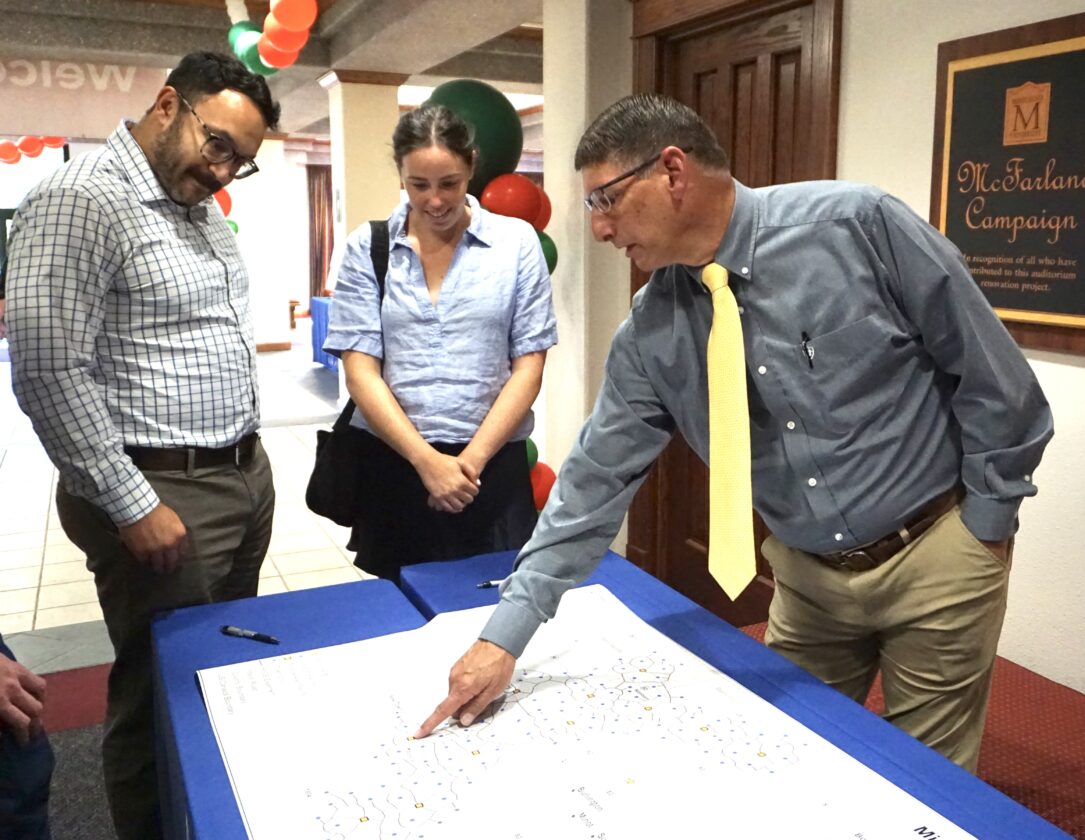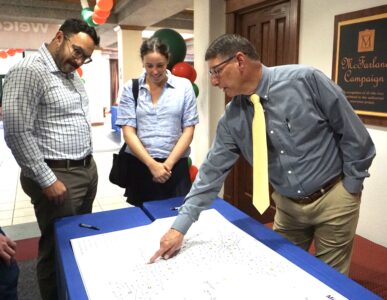Sentinel town hall tackles public questions

Jill Schramm/MDN Tim Barlow, right, with the U.S. Air Force, provides information on missile silo sites to Jason Hirshberg and Molly Woods, both Minot, at a Sentinel town hall in Minot Tuesday, Aug. 26.
Health, safety and logistics were on the minds of members of the public who attended a town hall meeting Tuesday, Aug. 26, on the U.S. Air Force’s proposed Sentinel missile replacement project coming to the Minot area.
Maj. Gen. Colin Connor, director of Intercontinental Ballistic Missile (ICBM) Modernization, explained the need to modernize the missile fields, comparing the existing 60-year-old equipment to dial-up internet and 35-year-old vehicles. The cost of a new system will be expensive upfront but inexpensive to maintain in comparison, he said.
“But as we need to modernize, it will be this community that makes it happen. It’ll be you and your kids because this is going to take a while,” Connor said. “It takes all of us to make this work.”
One former Air Force member from the 1970s asked if the Sentinel missiles will be safer than the Minuteman missiles have been.
“I’ve had a lot of friends that have come down with cancer very early,” he said. “We were put out on missile sites and not told the hazardous conditions out there. … I don’t want to see our young troops going out there and getting sick and not fulfilling a whole life like some of my friends.”
Connor responded Air Force Global Strike Command is taking an aggressive approach with an ongoing cancer study related to the missile fields. Gen. Thomas Bussiere has taken a personal interest, he said.
“But make no doubt about it, the system, the Sentinel system, will be safer. It will be built to current standards,” he said.
Sen. Kevin Cramer, R-ND, who attended the town hall, said he is grateful for the general’s direct attention to these issues, not just across the Air Force but for Minot specifically. He stressed how important the cancer question and answers are to the leadership of Global Strike.
Air Force staff also responded to the public’s questions about maintaining readiness during the missile replacement process.
“That’s what makes this program so unique and so different,” Connor said. “When we put Minutemen in the ground, we didn’t have an existing system, so you didn’t have those challenges.”
Connor explained the initial plan was to complete the project base by base across the three impacted bases to maintain a certain level of deterrence against an enemy during the process. The Air Force now is looking at the potential for a more simultaneous approach while still maintaining deterrence, he said.
“Minot is scheduled to be the last base to be modernized,” Cramer noted. “There’s one place that can never be shut down unless two other places can have its back, and that’s Minot.”
The job of Minot’s base commander will be to focus on the Minuteman missiles and make sure they remain operationally relevant until the day the last one comes out of the ground, Connor said. The best way to do that is to begin Sentinel, because as the Minuteman missiles are removed, they become parts for missiles still in the ground, he said.
“”We will have more pieces and parts for Minuteman III than we’ve ever had before,” Connor said.
Asked about whether the completed Sentinel sites will require fewer operations staff, Katie Parks, ICBM Program executive officer deputy, noted the modular design will make it easier to swap parts out at the missile sites, which will be advantageous when the temperature is negative 40.
“Largely, we’re trying to make everything a little more efficient to be better stewards of the money and the people, the human resources, that it takes to maintain and operate the systems,” Parks said.
The timing and the actual cost of the Sentinel project at Minot are unknown, and exactly how long it will take is an estimate. Parks said it will take probably 20 years, or into the 2040s, to get to 100% completion.
“We have to build for 400 missiles,” she said. “And then we have to get them all deployed.”
Connor also responded to questions about the property that may be needed for the project.
“The original plan was to use the original Minuteman III silos. Those silos are 60 years old now. If we use them for another 70 years, the simple math is they would be 130 years old at that time. And it’s really hard to maintain them at 130 years old,” Connor said of the decision to build new silos. “The goal is, as much as we can, to use the existing land that the government already owns.”
However, he added, there are sites, particularly in the Ryder area, that are prone to seasonal flooding and may need to be relocated.
The meeting introduced a legal adviser who will be among those working with landowners to see their concerns are addressed if damage claims come up during the construction.
The public also heard from Lt. Col. Nicholas Conover with the activation task force, described as the point person in charge of where the acquisition program and the operations program meet.
He asked that if people see something suspicious in the missile field during construction that they report it, because adversaries will be seeking information. Neighbors and citizens still will be able to exercise their rights in the area, but the guard will be against foreign agents, he said.
Conover also indicated keeping the public informed will be paramount as the Sentinel project progresses.
“I want to assure you that any questions or concerns are going to be answered,” he said. “You can anticipate that there are going to be more town halls that are going to occur.”
- Jill Schramm/MDN Tim Barlow, right, with the U.S. Air Force, provides information on missile silo sites to Jason Hirshberg and Molly Woods, both Minot, at a Sentinel town hall in Minot Tuesday, Aug. 26.






